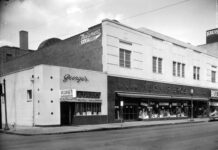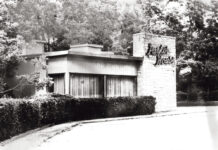
Georgia Cottage is a house braced by great stories. Some of them live in ink, others only in memories and in the voices that tell them to preserve them. It seems almost providential that so many of the home’s tenants would lend it their legends, whether those tales were brought forth there or linked to it through the illustrious names on the deed. It’s a site of divine inspiration, as if ingenuity rides the wind that flutters the leaves in the live oak boughs and stirs the cast iron plants. Maybe the creaking of floorboards, the vibrato of old hinges and the cracking of a settling house summon genius to the minds of people who hear those notes. Regardless of any mythical quality, history finds the regal estate. It’s seen much of it over the last two centuries, and its very existence is a record of some of the Mobile’s grandest chronicles.
One of Georgia Cottage’s most-devoted stewards referred to her home as a “gift house,” a sobriquet it earned by virtue of its design. Colonel John Murrell of Georgia had the structure built on 20 acres of a Spanish land grant for his daughter, Mary Del Barco, in honor of her marriage to William A. Hardaway. Despite taking Hardaway’s name, hers remained on the deed for as long as it was in their care — something that wouldn’t have been possible if she had been married more than a year prior. Southern states began enacting Married Women’s Property Acts that protected family assets in response to a major economic depression in 1837. The laws granted married women who were bequeathed property by their fathers to retain it without it being absorbed by their spouses. Separate holdings were secured against debt collectors, preventing financial ruin in times of economic distress. So, what came to Del Barco by birthright remained hers, and she kept it well until 1855.



LEFT One of seven fireplaces in Georgia Cottage. RIGHT The home’s vintage gas light fixtures were modernized for contemporary living when the home was outfitted with electrical wiring.
The home is a fine estate by any measure. The Creole cottage with Greek-Revival influences was constructed in 1840 by enslaved people brought to Mobile from Colonel Murrell’s Georgia property. The main section of the one-story house is skirted with a deep porch supported by six Tuscan columns with two jib windows on either side of the main entrance. A broad center hall balances two identical wings, each containing two rooms separated by pocket doors and a brick fireplace. The 14-foot-high ceilings, tall even by historic house standards, kept the vacation home in the village of Summerville cool during the South’s sauna months.
What the ceilings couldn’t save from heat was stored beneath the heart pine floorboards in the home’s basement. The cellar, a rare feature of houses constructed near coasts due to the potential for flooding, was used as food and wine storage. Legend suggests that it once harbored something more precious than preserves. Rumor has it that caches of Confederate gold and a fugitive Confederate Secretary of the Treasury were hidden in the vault following the Civil War to prevent their seizure by the federal government. Regardless of the story’s validity, it’s a compelling tale, and it’s only natural for the imagination to roam in a romantic house with silver doorknobs, brass chandeliers and a wishing well just outside the back door.
That romance called Georgia Cottage’s next residents to it when the Hardaways sold their home to Alfred Batre, who bought it for his new bride Hortense Addison, an heiress from one of Maryland’s wealthiest and most distinguished families from the colonial era. They likely made additions to the home, as two matching wings were added to each side of the house around the time of their tenure there, but no official records indicate when the work was completed. The couple lived in the cottage in wedded bliss for a couple of years before passing it to Matthew Evans, whose daughter would find literary inspiration within its plaster walls.
Augusta Evans moved with her family of 10 to Mobile in 1849 after her father suffered financial misfortune in San Antonio, Texas. The Evanses didn’t immediately occupy Georgia Cottage. They settled in the downtown area where Augusta was homeschooled by her mother and wrote her first novel by the age of 15. “Inez: A Tale of the Alamo,” a love story influenced by her time in Texas, was published anonymously in 1855. She used the proceeds to purchase Georgia Cottage for her father in 1857. She published her second novel, “Beulah,” two years later in her own name, which sold 22,000 copies in its first year and designated Augusta as Alabama’s first professional authoress.


LEFT A home tour information card. RIGHT Augusta Evans Wilson arranging flowers at her desk.
Her first two novels were just prologues to her success. She wrote her most famous works, “Macaria” and “St. Elmo,” at a desk in the corner of her bedroom at Georgia Cottage. It’s easy to imagine her dragging a pen across paper with the hem of her dress trailing away from the chair, her eyes lifting to the fireplace in winter and out the window in the spring as she paused to thread words into stories. It’s as if she conjured that image of herself when she carved her initials into a windowpane where her desktop met the glass.
Just as she left her mark on Georgia Cottage, it left its mark on her. She shared the place she saw as a haven with others who needed it during the Civil War, establishing a hospital in a vacant house near hers where she cared for sick and wounded soldiers. She so loved her childhood home that she married Lorenzo Madison Wilson in the parlor in 1868. The ceremony was a happy beginning and bittersweet farewell. After her nuptials, Augusta moved to Ashland Mansion with her husband, leaving Georgia Cottage behind. She was still able to visit from time to time until, with wistfulness and sentimentality, the family sold the house to Captain Andrew Damrell in 1879. They’d made their memories there, and it was time to give that privilege to someone else.
Damrell became well-known in his own right while living in Georgia Cottage. The young Army Corps of Engineers officer bought the house in 1879 after being sent to the Port City from New Orleans to revive a devastated Mobile following the Civil War. He became an army major while stationed in Mobile and oversaw the reopening of the Army Corps of Engineers office that closed shortly after Alabama’s secession from the Union.
As the city’s district engineer, he served on the Bay area’s Light House Board and worked with General Braxton Bragg to improve the Mobile Ship Channel, which had become obstructed from sunken ships and battle debris during the war. The man who earned the title “Father of the Mobile Ship Channel” served his country well while living at Georgia Cottage, and he loved his city dearly until he died in his home in 1909.
Damrell’s heirs kept Georgia Cottage in the family until 1926 when they sold it to J.N. Brownlee, who sold it to philanthropist and lumber baron Ben May nine years later. May moved to Alabama after taking a year’s worth of class at the Georgia Institute of Technology and, after recognizing the value of timber in the Bay area, began purchasing harvested woodlands to reforest them. His investments turned profits when he was asked to supply lumber to England in their war efforts. He used his fortune to found Gulf Lumber Company and expanded his holdings to other parts of Alabama, Florida and California.
Beyond his business ventures, he used his wealth to fund medical research in cardiology and oncology, even funding Sir Alexander Fleming’s clinical studies that led to the discovery of penicillin. His time owning Georgia Cottage was short, but his impact on Mobile was great, his trust having given millions of dollars to the Mobile Public Library and several educational organizations. The May name makes the home’s chain of title all-the-more illustrious.

May sold Georgia Cottage to a family who saw themselves as the fortunate keepers of a hallowed place. It was love once again that carried new homeowners over the threshold of the front door. Dr. Edward Simmons Sledge and his wife Mary Frank purchased the house in 1935. After withstanding war and nearly a century of perpetual occupancy, Georgia Cottage had lost its luster.
Mary Frank, who was described by another resident as a “determined and indomitable lady and a preservationist of the first order,” took up the mantle as the home’s custodian. Her restorations of the structure and collection of period-appropriate antiques from the 1800s earned Georgia Cottage the title of “most authentic Southern home and setting one can find.” Her graciousness and generosity added to its historicity, imbuing it with the Southern hospitality associated with such a residence. Her guests felt honored to visit her, and she felt honored to have them.
When it came to Georgia Cottage, Mary Frank held a hostess’s philosophy. She thought it selfish to keep such a beautiful piece of history hidden from admirers. She welcomed visitors frequently — some long-time friends, others she hadn’t had the privilege of knowing yet. She gave tours to the public, often charging nothing. Her paid tours could be purchased to the tune of a dollar, and each one she made was donated to the Historic Mobile Preservation Society.
During World War II, she opened her home to soldiers of Brookley Field and pilots of Bates Field often, and she wrote to their mothers to express her delight in their company. One young soldier in particular stole her affection. Upon discovering that his fiancee was flying to Mobile to visit him, Mary Frank arranged for the couple to be married in her parlor just as Augusta Evans and her husband had decades before.



One of Mary Frank’s own sons also patterned part of his life after the famed novelist. Eugene Sledge did not become an acclaimed author while living at Georgia Cottage as she did, but his childhood there undoubtedly shaped the life that would inspire his two renowned memoirs of his military exploits. He suffered a heart murmur after battling rheumatic fever, which somewhat hampered his physical abilities and led him to seek adventure in books and in the woods that skirted his realm of Mobile.
Eugene’s condition improved, and he went on to serve in the Marine Corps as a corporal in World War II. He kept notes of his experiences in his Bible while deployed overseas, which he referenced to write his books “With the Old Breed at Peleliu and Okinawa” and “China Marine.” His return to civilian life in Mobile was difficult. Warfare-related trauma altered his perception of the world and of the people who lived in it. He sought psychological rehabilitation and invested himself in academia, eventually earning his doctorate in biology and taking a position as a professor at what is now the University of Montevallo. Enduring the atrocities of war gave him his appreciation for the beauty of life, and his time in the woods near Georgia Cottage surely helped him find peace and loveliness in nature. As he recentered his life, Mary Frank conserved the place where it began.
Mary Frank knew wouldn’t be around forever to take care of her beloved home. She’d seen the threats Georgia Cottage might face in her absence. She fought the city when they proposed a widening of Springhill Avenue that would damage the live oaks on the property, leading to the formation of the Mobile Tree Commission. People suggested that she divide the sprawling property into multiple lots — a thought that would be the only thing she wouldn’t entertain.
The unofficially-appointed leader of preservation in the state of Alabama led a charge to protect her treasured residence, successfully advocating for Georgia Cottage to be added to the National Register of Historic Places and obtaining a grant of perpetual easement stipulating that any and all tenants would preserve the premises exactly in the condition she maintained it in perpetuity. Satisfied she’d safeguarded the fate of her estate, she passed it to Augustine Meaher III and his wife Mary Lou in 1976, whose six children played in the halls and ran on the lawn of the stately manor.



LEFT An antique manual doorbell. CENTER One of the two early symmetrical bedroom additions to Georgia Cottage. RIGHT The front-porch view of the avenue of live oaks leading to Augusta Evans’ historic home.
Mary Frank Sledge had faithfully restored and kept Georgia Cottage, but the Meahers modernized it for comfortable living. They had knob and tube electrical wiring replaced with a more-stable system, upgraded old furnaces, and added some rooms to the back of the house. A professional librarian, Mary Lou understood the importance of historical preservation, and she chose to keep the original siding of the house exposed on a wall when she added a den off the kitchen. A small addition was built alongside the den that would give the children their own bedrooms and bathrooms. There were other bedrooms throughout the house, but the added space provided the space necessary to house six children comfortably.
Like the Mary before her, Mary Lou was no stranger to playing a hostess. Though the home was large enough to host many visitors and had a natural flow between the rooms, she had a penchant for hosting events on her porch and on her lawn. It was no wonder that she wanted to showcase the grounds her family built. She and her family were horticulturally gifted. Mary Lou served as a volunteer for the Bellingrath Gardens and Home Foundation for many years, and her relatives worked with the head gardener of Bellingrath to create hybrid camellia varieties and design a yard suitable for a home of Georgia Cottage’s grandeur. What blooms in the spring lies dormant in the fall, and the cold-weather blossoms bring life to the grounds when all else green has returned to the earth.
The now-grown Meaher children take some of that life to their parents when they visit them in Magnolia Cemetery. Augustine was buried in the family plot under a canopy of oak trees in 2024 beside his wife Mary Lou, who preceded him in death in 2022. Their daughters pay their respects from time to time, stopping by to sweep away fallen leaves, pluck any willful weeds and deliver a bouquet of flowers their parents once tended. When the shrubs have buds to spare, they take a few to Augusta, who rests in a nearby grave. Their gift is more than a tribute to the esteemed writer. It is a gesture of their gratitude for their lives at Georgia Cottage, for the flowers they’re able to bring her and the honor of being part of her story.





